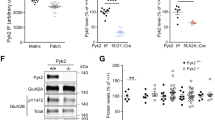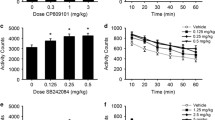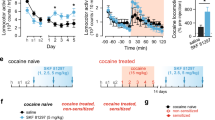Abstract
Rationale
Although locomotor response to d-amphetamine is considered as mediated by an increased release of dopamine in the ventral striatum, blockade of either α1b-adrenergic or 5-HT2A receptors almost completely inhibits d-amphetamine-induced locomotor response in mice. In agreement with this finding, mice lacking α1b-adrenergic receptors hardly respond to d-amphetamine. However, we show here that, paradoxically, mice lacking 5-HT2A receptors (5-HT2A-R KO) exhibit a twofold higher locomotor response to d-amphetamine than wild-type (WT) littermates.
Objectives
To explore why there is a discrepancy between pharmacological and genetic 5-HT2A receptor blockade.
Materials and methods
Locomotor response and behavioral sensitization to d-amphetamine were measured in presence of prazosin and/or SR46349B, α1b-adrenergic, and 5-HT2A receptor antagonists, respectively.
Results
Repeating amphetamine injections still increases 5-HT2A-R KO mice locomotor response to d-amphetamine at a level similar to that of sensitized WT mice. SR46349B (1 mg/kg) has, as expected, no effect in 5-HT2A-R KO mice. One milligrams per kilogram of prazosin completely blocks d-amphetamine-induced locomotor response in 5-HT2A-R KO naïve animals but 3 mg/kg is necessary in sensitized 5-HT2A-R KO mice.
Conclusions
Because naïve 5-HT2A-R KO mice exhibit an increased cortical noradrenergic response to d-amphetamine, our data suggest that repeated d-amphetamine modifies noradrenergic transmission in 5-HT2A-R KO mice. Stimulation of specific 5-HT2A receptors would inhibit noradrenergic neurons. Dramatic decrease in SR46349B efficiency in sensitized WT mice indicates that a disruption of the regulating role of 5-HT2A receptors on noradrenergic transmission occurs during sensitization and thus represents the physiological basis of behavioral sensitization to d-amphetamine.





Similar content being viewed by others
References
Antelman SM, Caggiula AR (1977) Norepinephrine-dopamine interactions and behavior. Science 195:646–653
Auclair A, Cotecchia S, Glowinski J, Tassin JP (2002) d-Amphetamine fails to increase extracellular dopamine levels in mice lacking alpha 1b-adrenergic receptors: relationship between functional and nonfunctional dopamine release. J Neurosci 22:9150–9154
Auclair A, Blanc G, Glowinski J, Tassin JP (2004a) Role of serotonin 2A receptors in the d-amphetamine-induced release of dopamine: comparison with previous data on alpha1b-adrenergic receptors. J Neurochem 91:318–326
Auclair A, Drouin C, Cotecchia S, Glowinski J, Tassin JP (2004b) 5-HT2A and alpha1b-adrenergic receptors entirely mediate dopamine release, locomotor response and behavioural sensitization to opiates and psychostimulants. Eur J Neurosci 20:3073–3084
Besson MJ, Cheramy A, Feltz P, Glowinski J (1971) Dopamine: spontaneous and drug-induced release from the caudate nucleus in the cat. Brain Res 32:407–424
Blanc G, Trovero F, Vezina P, Herve D, Godeheu AM, Glowinski J, Tassin JP (1994) Blockade of prefronto-cortical alpha 1-adrenergic receptors prevents locomotor hyperactivity induced by subcortical d-amphetamine injection. Eur J Neurosci 6:293–298
Bortolozzi A, Diaz-Mataix L, Scorza MC, Celada P, Artigas F (2005) The activation of 5-HT receptors in prefrontal cortex enhances dopaminergic activity. J Neurochem 95:1597–1607
Cavalli A, Lattion AL, Hummler E, Nenniger M, Pedrazzini T, Aubert JF, Michel MC, Yang M, Lembo G, Vecchione C, Mostardini M, Schmidt A, Beermann F, Cotecchia S (1997) Decreased blood pressure response in mice deficient of the alpha1b-adrenergic receptor. Proc Natl Acad Sci USA 94:11589–11594
Chiang C, Aston-Jones G (1993) A 5-hydroxytryptamine2 agonist augments gamma-aminobutyric acid and excitatory amino acid inputs to noradrenergic locus coeruleus neurons. Neuroscience 54:409–420
Darracq L, Blanc G, Glowinski J, Tassin JP (1998) Importance of the noradrenaline-dopamine coupling in the locomotor activating effects of d-amphetamine. J Neurosci 18:2729–2739
Dickinson SL, Gadie B, Tulloch IF (1988) Alpha 1- and alpha 2-adrenoreceptor antagonists differentially influence locomotor and stereotyped behaviour induced by d-amphetamine and apomorphine in the rat. Psychopharmacology (Berl) 96:521–527
Doherty MD, Pickel VM (2000) Ultrastructural localization of the serotonin 2A receptor in dopaminergic neurons in the ventral tegmental area. Brain Res 864:176–185
Drouin C, Darracq L, Trovero F, Blanc G, Glowinski J, Cotecchia S, Tassin JP (2002) Alpha1b-adrenergic receptors control locomotor and rewarding effects of psychostimulants and opiates. J Neurosci 22:2873–2884
Fiorica-Howells E, Hen R, Gingrich J, Li Z, Gershon MD (2002) 5-HT(2A) receptors: location and functional analysis in intestines of wild-type and 5-HT(2A) knockout mice. Am J Physiol Gastrointest Liver Physiol 282:877–893
Heisler LK, Tecott LH (2000) A paradoxical locomotor response in serotonin 5-HT(2C) receptor mutant mice. J Neurosci 20:RC71
Ichikawa J, Meltzer HY (1995) DOI, a 5-HT2A/2C receptor agonist, potentiates amphetamine-induced dopamine release in rat striatum. Brain Res 698:204–208
Kelly PH, Seviour PW, Iversen SD (1975) Amphetamine and apomorphine responses in the rat following 6-OHDA lesions of the nucleus accumbens septi and corpus striatum. Brain Res 94:507–522
Kokkinidis L, Anisman H (1978) Involvement of norepinephrine in startle arousal after acute and chronic d-amphetamine administration. Psychopharmacology (Berl) 59:285–292
Kokkinidis L, Anisman H (1979) Circling behavior following systemic d-amphetamine administration: potential noradrenergic and dopaminergic involvement. Psychopharmacology (Berl) 64:45–54
Lategan AJ, Marien MR, Colpaert FC (1990) Effects of locus coeruleus lesions on the release of endogenous dopamine in the rat nucleus accumbens and caudate nucleus as determined by intracerebral microdialysis. Brain Res 523:134–138
Moser PC, Moran PM, Frank RA, Kehne JH (1996) Reversal of amphetamine-induced behaviours by MDL 100,907, a selective 5-HT2A antagonist. Behav Brain Res 73:163–167
Ogren SO, Archer T, Johansson C (1983) Evidence for a selective brain noradrenergic involvement in the locomotor stimulant effects of amphetamine in the rat. Neurosci Lett 43:327–331
O’Neill MF, Heron-Maxwell CL, Shaw G (1999) 5-HT2 receptor antagonism reduces hyperactivity induced by amphetamine, cocaine, and MK-801 but not D1 agonist C-APB. Pharmacol Biochem Behav 63:237–243
Pazos A, Cortes R, Palacios JM (1985) Quantitative autoradiographic mapping of serotonin receptors in the rat brain. II. Serotonin-2 receptors. Brain Res 346:231–249
Pijnenburg AJ, Honig WM, Van Rossum JM (1975) Inhibition of d-amphetamine-induced locomotor activity by injection of haloperidol into the nucleus accumbens of the rat. Psychopharmacologia 41:87–95
Porras G, Di Matteo V, Fracasso C, Lucas G, De Deurwaerdere P, Caccia S, Esposito E, Spampinato U (2002) 5-HT2A and 5-HT2C/2B receptor subtypes modulate dopamine release induced in vivo by amphetamine and morphine in both the rat nucleus accumbens and striatum. Neuropsychopharmacology 26:311–324
Rinaldi-Carmona M, Congy C, Santucci V, Simiand J, Gautret B, Neliat G, Labeeuw B, Le Fur G, Soubrie P, Breliere JC (1992) Biochemical and pharmacological properties of SR 46349B, a new potent and selective 5-hydroxytryptamine2 receptor antagonist. J Pharmacol Exp Ther 262:759–768
Salomon L, Lanteri C, Glowinski J, Tassin JP (2006) Behavioral sensitization to amphetamine results from an uncoupling between noradrenergic and serotonergic neurons. Proc Natl Acad Sci USA 103:7476–7481
Shi WX, Pun CL, Zhang XX, Jones MD, Bunney BS (2000) Dual effects of d-amphetamine on dopamine neurons mediated by dopamine and nondopamine receptors. J Neurosci 20:3504–3511
Snoddy AM, Tessel RE (1985) Prazosin: effect on psychomotor-stimulant cues and locomotor activity in mice. Eur J Pharmacol 116:221–228
Sorensen SM, Kehne JH, Fadayel GM, Humphreys TM, Ketteler HJ, Sullivan CK, Taylor VL, Schmidt CJ (1993) Characterization of the 5-HT2 receptor antagonist MDL 100907 as a putative atypical antipsychotic: behavioral, electrophysiological and neurochemical studies. J Pharmacol Exp Ther 266:684–691
Szabo ST, Blier P (2001) Functional and pharmacological characterization of the modulatory role of serotonin on the firing activity of locus coeruleus norepinephrine neurons. Brain Res 922:9–20
Szabo ST, Blier P (2002) Effects of serotonin (5-hydroxytryptamine, 5-HT) reuptake inhibition plus 5-HT(2A) receptor antagonism on the firing activity of norepinephrine neurons. J Pharmacol Exp Ther 302:983–991
Taghzouti K, Simon H, Herve D, Blanc G, Studler JM, Glowinski J, LeMoal M, Tassin JP (1988) Behavioural deficits induced by an electrolytic lesion of the rat ventral mesencephalic tegmentum are corrected by a superimposed lesion of the dorsal noradrenergic system. Brain Res 440:172–176
Tassin JP, Studler JM, Herve D, Blanc G, Glowinski J (1986) Contribution of noradrenergic neurons to the regulation of dopaminergic (D1) receptor denervation supersensitivity in rat prefrontal cortex. J Neurochem 46:243–248
Von Voigtlander PF, Moore KE (1973) Involvement of nigro-striatal neurons in the in vivo release of dopamine by amphetamine, amantadine and tyramine. J Pharmacol Exp Ther 184:542–552
Weisstaub NV, Zhou M, Lira A, Lambe E, Gonzalez-Maeso J, Hornung JP, Sibille E, Underwood M, Itohara S, Dauer WT, Ansorge MS, Morelli E, Mann JJ, Toth M, Aghajanian G, Sealfon SC, Hen R, Gingrich JA (2006) Cortical 5-HT2A signaling modulates anxiety-like behaviours in mice. Science 313:536–540
Acknowledgments
We thank L. Lanfumey and M. Hamon for 5-HT2A-R KO mice, S. Cotecchia for α1b-AR KO mice, J. Naudé for statistical advice, and P. Babouram for skilful technical assistance.
Author information
Authors and Affiliations
Corresponding author
Rights and permissions
About this article
Cite this article
Salomon, L., Lanteri, C., Godeheu, G. et al. Paradoxical constitutive behavioral sensitization to amphetamine in mice lacking 5-HT2A receptors. Psychopharmacology 194, 11–20 (2007). https://doi.org/10.1007/s00213-007-0810-3
Received:
Accepted:
Published:
Issue Date:
DOI: https://doi.org/10.1007/s00213-007-0810-3




